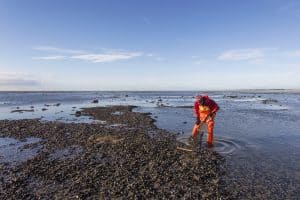When Australia harmonised its occupational health and safety (OHS) laws, the management focus broadened to include work, and not just workplaces. Some “knowledge” or white-collar work can be done anywhere, and employers have often struggled to understand how to extend their OHS management systems and duties to apply to this revised or expanded system of work. Current OHS guidance on working from home is too “big picture” when employers are addressing localised decisions.
Category: electricity
Hi-viz and safety – it’s all about the context
 High visibility clothing has spread from the work site to the public arena and, as such, has complicated the reasons for hi-viz clothing. However the fundamental underpinning of high-viz is to contrast against the surrounding environment. This contrast does not only relate to clothing but also signage.
High visibility clothing has spread from the work site to the public arena and, as such, has complicated the reasons for hi-viz clothing. However the fundamental underpinning of high-viz is to contrast against the surrounding environment. This contrast does not only relate to clothing but also signage.
Several years ago, a couple of women from Tasmania visited the offices of SafetyAtWorkBlog to discuss the practicality of hi-viz vests for toddlers and small children. The hi-viz logic of the work site is easily applied to the public park or farms. A contrasting colour to the trees or bushland would make it easier to identify someone, like a wayward child. On a work site, the hi-viz is more about identifying a hazard, whether that be a person, an overhead wire or a work boundary.
WorkSafe Victoria missteps on its venture with “Candid Camera” approach
WorkSafe Victoria has released a video of an experiment that shows that people will undertake unsafe acts if asked to do so. This video is part of the OHS regulator’s campaign to increase focus on the OHS obligations of supervisors but it has generated serious complaints from safety professionals and advocates.
WorkSafe Victoria has been advised that the video sends “mixed messages” about electrical safety. Safety professionals have decried that the video is meant to be funny with its jaunty whistling soundtrack yet it shows an apprentice pretending to receive a shock. One participant giggles when she realises it is a joke, in the same way people are relieved after being “punk’d” or laugh after seeing the “candid camera” even though their participation was alarming. The video has been described as a “stunt” that fails to illustrate the serious consequences of the action of handling live electric cables. Continue reading “WorkSafe Victoria missteps on its venture with “Candid Camera” approach”
Rainbow windmill deaths continue to affect the local community
In March 2010, SafetyAtWorkBlog reported on the deaths of two farmers in the rural town of Rainbow in Victoria. They died when a windmill they were transporting on a property made contact with overhead power lines. The deaths continue to be a difficult topic of discussion throughout the Wimmera-Mallee, as I found out over the Christmas holiday season.
The coronial inquest into the deaths of John and Michael Helyar began in Horsham in November 2010 and will continue in April 2011. Some of the inquest reports in the local newspaper make for harrowing reading but also provide an important insight into the decision-making process that occurs at the site of a workplace fatality and one that involves close friends.
The two articles are
Coronial inquest into tragedy at Rainbow, and
Company pleads guilty over insulation installer death
In June 2010, Arrow Property Maintenance Pty Ltd was charged with failing to conduct its business or undertaking in a way that was electrically safe, after, accoridng to one media report:
“[A] 16-year-old boy was electrocuted while installing fibreglass insulation in the ceiling of a home at Stanwell, west of Rockhampton, on November 18, 2009.”
On 14 September 2010, Queensland Industrial Magistrate John McGrath heard the company plead guilty. Continue reading “Company pleads guilty over insulation installer death”
More OHS charges laid over insulation installer deaths
The OHS investigation process into the deaths of installers of insulation in Australia has led to charges being laid against Arrow Property Maintenance Pty Ltd.
On 28 June 2010, Queensland’s Department of Justice and Attorney-General has charged the company with breaches of both the Electrical Safety Act 2002 and the Workplace Health and Safety Act 1995 following an extensive investigation into the fatal electrocution of a 16-year-old teenage insulation installer in Stanwell in 2009.
The charges relate to unsafe electrical work and unsafely working at height during the installation of fibreglass insulation.
Interestingly the Department has also mentioned in its media release (not yet available online) a separate prosecution under the Electrical Safety Act 2002 that is strengthened by it also being an
“… alleged breach of a Ministerial Notice issued on 1 November 2009 Continue reading “More OHS charges laid over insulation installer deaths”
What the mobile phone/cancer study means for workplaces
Over the last few days there has been considerable media attention around the world about the Interphone study into mobile phones and cancer. The report says that there is an increased risk of some brain cancers for heavy mobile phone users but is this a concern for employers who are obliged to provide a workplace and work activity that is without risk?
The Interphone study is important for many reasons but ultimately it established an anchor point or a reference point on mobile phones and cancer. The fact that it was largely inconclusive, in this context, is far less important. Professor Bruce Armstrong summed up his take on the report in a media briefing on 18 May 2010 where he acknowledged continuing uncertainty on the hazard of brain tumours and mobile phones. Listen to Prof. Armstrong below:
Continue reading “What the mobile phone/cancer study means for workplaces”

